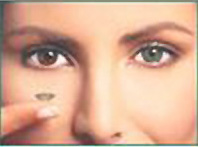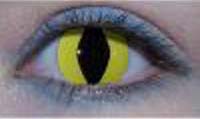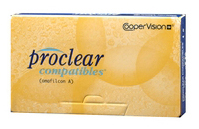Before we begin talking specifically about contacts, let's review how vision works and how lenses correct refractive vision problems. If you've already read
How Vision Works and
How Refractive Vision Works you may want to skip to the
next section.
For people with normal vision, light rays enter the cornea in the front of the eye and are focused into a single point on the retina in the back of the eye. Once it hits the retina, the light is converted into signals, which go to the brain to be processed into images.
Sometimes the cornea doesn't focus light precisely on the retina because of a refractive error. The contact lens refracts, or bends light, so that it focuses correctly on the retina. Its shape is based on the type of vision problem that needs to be corrected. How much the lens bends light, or its strength, is expressed in diopters. The higher the diopter, the stronger the lens.
If the eyeball is too long, causing it to focus light rays in front of the retina, the result is myopia, or nearsightedness. People with myopia can see clearly close-up, but their distance vision is blurry. To correct myopia, the contact lens is thinner at the center than at the edges. These lenses are called minus, or concave. They spread the light away from the center of the lens and move the focal point of the light forward, so that it reaches the retina.
Hyperopia, or farsightedness, happens when the eyeball is too short, causing it to focus light rays behind the retina. People with hyperopia can see clearly far away, but their close-up vision is blurry. To correct hyperopia, the lens is thicker at the center and thinner at the edges. These lenses are called plus, or convex. The lens bends the light toward the center and moves the focal point back so that light is focused on, rather than behind, the retina.
An irregularly-shaped cornea causes light to focus at several points, distorting vision. This is called astigmatism. To correct astigmatism, the lens is designed specifically to the individual's correction needs. Whereas lenses used to correct myopia and hyperopia are spherical (the power correction is the same throughout the lens) astigmatism requires a special lens, called a toric lens.
Toric contact lenses are made from the same materials as spherical lenses, but they have different angled curvatures to correct vision specifically for each individual. Toric lenses may be thicker in certain parts of the lens and thinner in other parts. They have two powers: one to correct for astigmatism, and the other to correct for myopia or hyperopia, if needed. They are also weighted more along the bottom or have thin edges along the top and bottom to keep them fixed in one position on the eye.
With presbyopia, the eye loses its ability to accommodate from near to far focus. This often occurs as people get older. Because presbyopia requires both near and far correction, people with this error often require special bifocal or multifocal lenses:
A concentric bifocal lens has the near correction in a small circle at the center of the lens, and the distance correction in the outer lens surrounding it (alternately, the distance correction can be placed in the center of the lens and the near correction on the outside of the lens).
A translating lens mimics bifocal glasses. The lens is divided, with the distance correction at the top and the near correction at the bottom.
An aspheric lens places both the near and far correction near the center of the lens. Some people with presbyopia may need a technique called monovision. It uses the dominant eye for distance vision, and the other eye for near vision. Each eye is fitted with a different lens appropriate for the vision correction needed.
In the next section, we'll look at the different types of contact lenses available.









